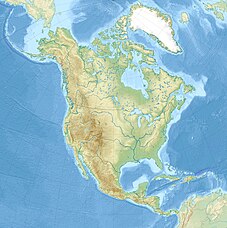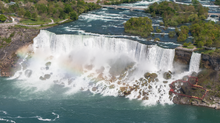Niagara Falls
|
|
|
||

View from Skylon Tower to Niagara Falls
|
|||
The Niagara Falls ( English Niagara Falls [ naɪˌæɡ (ə) ɹəˈfɔːlz ]) are waterfalls of the Niagara River on the border between the US state of New York and the Canadian province of Ontario .
Niagara Falls is also the name of the two sister cities Niagara Falls in the US state of New York and Niagara Falls in the Canadian province of Ontario , in the center of which the falls are located.
geography
The Niagara River connects Lake Erie with Lake Ontario . At Niagara Falls, he falls 57 meters. The islands of Luna Island and Goat Island (goat island) at the top split the falls into three parts: the American Falls and the smaller Bridal Veil Falls , both of which are exclusively on US territory, and the Horseshoe Falls , through which the border between the US is located and Canada runs. The American Falls have an edge length of 260 m, the Horseshoe Falls one of 670 m. The water of the American Falls falls over an edge of 21 to 34 m high onto a slag pile that was created in a rock fall in 1954. The Horseshoe Falls has a free fall height of 57 m. Ships circumnavigate the falls through the 43.4 km long Welland Canal, twelve kilometers to the west .
The water flow of the Niagara River averages 5750 m³ / s, with at least 2832 m³ / s (about half of the total water masses) falling down the falls during the day. The remaining water mass is diverted via a weir to generate electricity. At night the waterfalls are throttled to at least 1416 m³ / s (about a quarter of the total water flow). During the season, the waterfalls are switched on every morning at the push of a button.
geology
12,000 years ago, at the end of the last glacial period, the last large glaciers in this area melted and caused Lake Erie to overflow. The meltwater formed the Niagara River, which poured over the cliffs of the Niagara layer into Lake Ontario.
The layer level has a geological peculiarity: under the hard dolomite rock of the surface there is softer slate . The water masses at the foot of the falls erode the shale until the overhang of hard dolomite no longer holds and falls into the river bed . The erosion is about 1.8 meters per year. In this way, since their formation, the falls have already moved 11 kilometers away from the Niagara layer towards Lake Erie. The Niagara Whirlpool , which is about 5 kilometers below the falls, was created on this retreat . From Niagara Falls further upriver it is about 28 kilometers to Lake Erie.
By partially diverting the river to hydropower plants a few kilometers away , the falling water volumes are reduced. By withdrawing water for the power plants, the force of the falls has been reduced and the erosion slowed down.
Falling dry, freezing over
On the night of March 29, 1848, Niagara Falls temporarily dried up. A storm had set the ice floes on Lake Erie in motion and blocked the river's exit at Buffalo for nearly thirty hours before they started moving again and the river could flow again. Many people in the surrounding cities sought out the dry river.
In June 1969, the American Falls were drained and geologically examined for five months. Concrete was also pressed into the rock to stop erosion. The idea of eliminating the dump created in 1954 was abandoned, also because it stabilized the wall over which the American Falls fall.
On January 26, 1936, Niagara Falls was largely frozen over. It had been particularly cold for weeks before. In February 2015 they were largely frozen over.
Driving and crossing
Numerous visits to Horseshoe Falls have been attempted so far. For example, some people rushed down the falls in padded barrels or boats . The first documented case dates back to 1829. About every second attempt was fatal. The 63-year-old teacher Annie Taylor made the first successful ascent on October 24, 1901 in a wooden barrel. Attempts to enter the building are a criminal offense and have been punished with relatively high fines or imprisonment since the 1980s. Because the American Falls have the lesser current and have plunged onto a large slush pile since 1954, it is not known that a human has ever plunged down this part of the falls and survived.
On July 9, 1960, the then seven-year-old Roger Woodward got out of a capsized motorboat above the Horseshoe Falls and fell down the falls. He was wearing a life jacket and was rescued by the crew of the excursion boat " Maid of the Mist II". He was uninjured except for a mild concussion, for which he was treated at the local hospital for three days. His sister Deanne was dragged out of the Niagara River by two passers-by above the falls. James Honeycutt of Niagara Falls, New York , a family friend who had taken the siblings on the boat trip, did not survive the fall over the falls; his body was found four days later.
Kirk Jones from Canton, Michigan is considered the first person to survive a fall at Niagara Falls without any aids. He threw himself down the horseshoe fall on October 20, 2003 and survived with two broken ribs, bruises and abrasions. He was temporarily admitted to the psychiatric ward at Niagara Hospital, where he said he planned his action with intent to commit suicide . Relatives contradicted this claim, saying that Jones' aim was to get known and find work. Later statements by Jones suggest that he accepted both possibilities as a result. On April 19, 2019, Jones died after jumping again.
On June 16, 2012, the 33-year-old American high- wire artist Nik Wallenda , great-grandson of the famous German acrobat Karl Wallenda (1905–1978), was the first person to cross the Niagara Falls at the Horseshoe Falls with the help of a stretched from the American to the Canadian side Wire rope. He covered the 330-meter route in around 25 minutes. Wallendas action was broadcast live on the American television station ABC .
Power plants
Hydro power has been used along the river since the 18th century ; from 1759 initially as a drive for water mills , from 1882 then for power generation in the first power station. The system was operated with water from the Hydraulic Canal and was used exclusively to generate direct current for lighting purposes in the immediate vicinity. From 1886 the plans for the Edward Dean Adams Power Plant took place, the power plant for AC voltage was put into operation in 1895 and achieved an output of 78.3 MW and was the world's largest power plant at the time. The Edward Dean Adams Power Plant ceased operations in 1961 after the new, more powerful Robert Moses Niagara power plant with an installed capacity of 2.4 GW went into operation.
In order not to diminish the natural spectacle of the waterfalls too much for visitors, the USA and Canada signed a contract in 1950 which stipulated that during the tourist season a maximum of 50% of the total amount of water may be diverted to the power plants on average during the day. Outside the season, the proportion increases to around 75%. As a side effect of the reduced amount of water, the erosion of the falls was also noticeably reduced.
tourism
The tourist development began in 1800. Trips with the Maid of the Mist boats have been offered since 1846. In 1885, New York State declared Niagara Falls a nature reserve , and the Canadians followed suit a year later. Nevertheless, the falls never received UNESCO World Heritage status . With more than 18 million visitors annually, the Niagara region is one of the most popular tourist attractions in North America.
The Maid of the Mist boat tours are now also offered by the Canadian competitor Hornblower Niagara Cruises . On the Canadian side, the Journey Behind the Falls viewpoint was created directly on the edge of the fall. On the US side, the Cave of the Winds hiking trail has been built, which also offers spectacular views of the falls.
Television and film
- In 1953 the film Niagara with Marilyn Monroe was made .
- In 1979, the Falls played a pivotal role in the showdown in Deadly Embrace with Roy Scheider .
- In 1980, parts of Superman II - Alone Against All were filmed on the falls .
- 2003 came the film comedy Bruce Almighty (original title: Bruce Almighty) with Jim Carrey , in which the Niagara Falls play a role at the beginning of the film.
- In 2004, the falls were the location of the television series Wonderfalls .
- In 2007, the waterfalls were the model for the scenes of the end of the world in the film Pirates of the Caribbean .
- In 2009, Jim and Pam wed in the office outside Niagara Falls before heading out for their actual wedding.
Panoramas

Name bearer
The New York Central Railroad named their steam locomotives with the Northern (2'D2 ') wheel arrangement with the name Niagara .
Web links
Footnotes
- ↑ a b c d www.niagaraparks.com: Niagara Falls Geology Facts & Figures. Retrieved December 13, 2015.
- ^ A b The 1950 Niagara Treaty , International Niagara Board of Control
- ↑ on the cold spell, see en: 2014–15 North American winter
- ↑ Article on Roger Woodward. In: infoniagara.com
- ↑ Article on Kirk Jones , niagarafrontier.com
- ↑ Jake Halpern: Without a Barrel. In: Outside Magazine , June 1, 2004
- ↑ Michigan native who survived Niagara Falls plunge dies after apparent 2nd attempt - with a snake. Detroit Free Press, December 15, 2019, accessed July 18, 2020 .
- ↑ Thomas Schmidt: Hochseilakt about a roaring inferno ( Memento from September 5, 2012 in the Internet Archive ) In: tagesschau.de , June 16, 2012, accessed on June 16, 2012
- ↑ http://www.niagarafrontier.com/power.html#Origins
- ^ Business Men's Association of Niagara Falls, NY: The Water-power of the falls of Niagara applied to manufacturing purposes: the hydraulic tunnel of the Niagara Falls Power Company . Business Men's Association of Niagara Falls, 1890, p. 11.
- ^ Early Electrification of Buffalo. In: Engineering and Technology History Wiki. Retrieved September 30, 2018 .
- ↑ Inventory Nomination Form for National Register of Historical Places. (PDF) National Park Service , accessed December 30, 2013 .
- ^ Niagara Falls - History of Power. Retrieved August 25, 2015 .
- ↑ Niagara Falls Geology Facts & Figures. In: niagaraparks.com
- ↑ http://www.kanada-ontario.de/niagara/
- ↑ https://www.niagaracruises.com/
- ↑ Pirates of the Caribbean - Film Locations
Coordinates: 43 ° 4 ′ 41 ″ N , 79 ° 4 ′ 33 ″ W.










